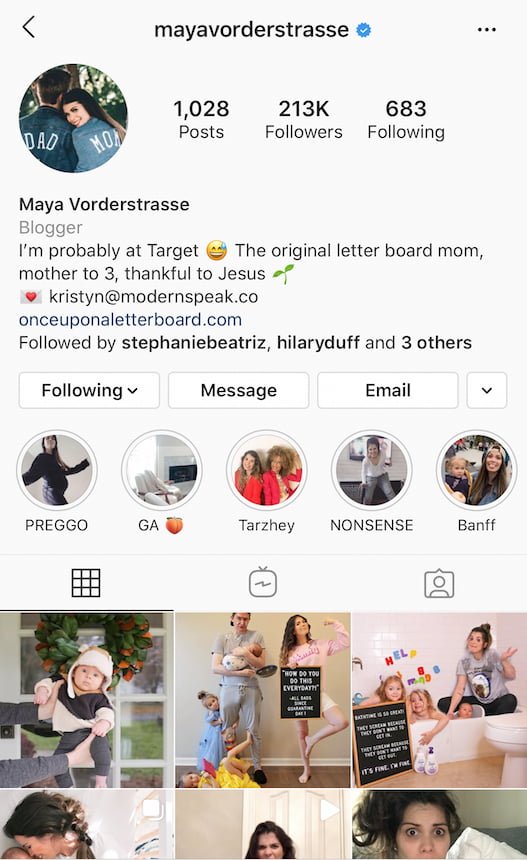1. Determine Your Objective
Just like with any marketing push, you need to know what results you want before you begin. Otherwise, it’s impossible to strategize a way to reach those goals. For example, ask yourself, do you want to:
- Promote a new product?
- Raise brand awareness?
- Break into a new market?
- Change how you’re perceived?
Once you’ve determined this, everything else can fall into place.
2. Map Out Your Budget
Before you get your heart set on specific influencers, promo ideas, or reach, nail down your budget. You’ll have to be a bit flexible (more on that in a moment). But a firm grasp on what you can spend will ensure you invest confidently—and that you see a strong ROI.
3. Set Realistic Goals
Study your particular industry and be aware of the kind of results social media influencer partnerships bring within it. Set achievable (but ambitious) goals for KPIs; otherwise, you’re setting yourself up to fail. And remember, a first campaign (at minimum) is likely to be full of trial and error.
4. Clarify Your Brand Image
Nail down exactly what sort of brand/product image you want conveyed, i.e., your brand image, and craft your content and messaging to encourage that vibe. Build a list of guidelines to send to social media influencers (“post should include these terms,” “avoid x, y, z.”)
Most importantly, stay consistent. Don’t sell yourself as a luxury brand with high-end fashionista social influencers and then turn around and market as a budget brand with mommy bloggers. Also remember, influencers have their own brand and identity. Allow them to be themselves, as long as it doesn’t damage your brand image
5. Vet Influencers and Their Audience
(Warning: this is the most involved and lengthy step but well worth the effort.)
Start narrowing down the influencers you’d like to work with and vet them carefully. Don’t pick someone with a problematic past—you’re likely to get “canceled” along with them. Be mindful of vanity metrics. For instance, someone with 15,000 followers but 6 likes per post won’t land you valuable engagement.
For SMBs, consider focusing on niche influencers who truly target your demographic; don’t get starstruck and only go for big names. For example, Target works with the likes of Chrissy Teigen and Joanna Gaines for their product partnerships, but on social media, they opt for micro-influencers. They call them their Target Talent, and Mommy influencers like Maya Voderstrasse provide an authentic person that appeals to their demographic differently than their famous counterparts. Yes, she still has a large following, but it’s a different level than a typical celebrity. (Also, niche influencers likely have a lower price tag.)

Focus on quality interactions instead of reach (the opposite of the old “eyes on a billboard” mentality). Make sure the way their audience interacts with them aligns with your goals before you reach out. To confirm their performance, you’ll want to ask for metrics or proof related to desired actions. For example, if you’d like to drive website traffic, ask them for data that shows high click-to-website rates from an influencer post. (Note: You’ll do this in the pitch/negotiation steps, which are listed next, but you want to keep these things in mind while you research.)
6. Send Out Initial Pitches
Start contacting your list of vetted social influencers to find out if they’re interested in a partnership. Many influencers offer multiple pricing options or have different tiers of engagement they can provide depending on your budget. Make sure you’re both on the same page and establish clear expectations for both parties.
7. Negotiate
When you start getting responses, you’ll likely have to negotiate with the social media influencers. (This is where that aforementioned flexibility comes in.) They may request free products, a certain amount of exposure, or more creative freedom than you initially requested. Figure out what you’re willing to offer, what you can give on, and what’s a dealbreaker for you.
This step is also where you’ll want to request data-backed proof or case studies of their previous successes.
Hint, have a written contract to outline your terms.
8. Accept When Someone Isn’t a Good Fit
While some social influencers may seem like the perfect partner on paper, in practice, they may not be. Some influencers set rigid personal standards for what brands they work with. (For instance, many beauty bloggers will only work with cruelty-free brands.) Plus, the influencer has to feel you’re a good fit for their audience and identity. If someone gives you a hard no, accept it graciously and move on. Alternatively, if someone you love has over-the-top contract requirements, consider that a preview into what it will be like to work with them.
9. Be Mindful of Analytics
Treat an influencer partnership like you would any other social media campaign: track it. Utilize specific URLs and UTM codes to be certain you know where your traffic is coming from. And be prepared to act on it. The beauty of influencer campaigns is that they allow you to be agile and change the elements that aren’t working in the moment.
10. Reach Out to Experts
Lastly, large-budget influencer campaigns can be challenging—especially the first time. As with any specialized task, outsourcing to experts can be your best bet. Even if you just need an agency to help with outreach and setting up your contracts and process, experienced professionals can easily create that foundation.
Use Social Influencers to Level Up Your Brand Presence
Take advantage of recently expanded online communities and surges in engagement by using social influencers to boost your new campaign. By following this proven process, you’re more likely to see a high ROI from your partnerships. Dive in, and see what social influencers can do for your business!
Remember, you don’t have to go it alone; our team’s ready to help you make the most of your campaign. Find out what we can do for you today, and give yourself the best chance of succeeding.
By Caitlin Morse, PR Manager at 10x digital

